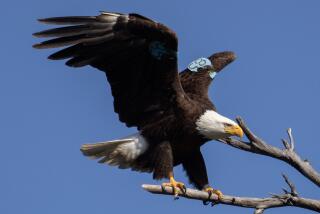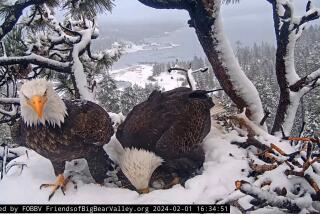Bald Eagle Lays 1st Egg on Island in 50 Years
- Share via
For the first time in more than half a century, a bald eagle has laid an egg on Santa Cruz Island, marking a major milestone for scientists overseeing a restoration program of the federally protected species on the northern Channel Islands.
After years of attempting to repopulate the eight islands off the coast with bald eagles, biologists confirmed this week the sighting of an egg in a nest established last fall by two young birds. If viable, the egg could hatch during the second week of April, experts said.
“It is a pretty exciting event,” said David Garcelon, president of the Northern California-based Institute for Wildlife Studies, which manages the restoration program. “If they don’t give up, and if the egg is actually fertile, I’d give them a better than 50-50 chance” of producing a bald eagle chick.
Yvonne Menard, spokeswoman for the National Park Service, which co-owns the island with the Nature Conservancy, said scientists are in the final year of a five-year project to return bald eagles to Santa Cruz. The last known successful nesting of a bald eagle on the northern Channel Islands was in 1949 on Anacapa Island.
Since then, bald eagles have been unable to reproduce on the islands without human help because their eggs contain high levels of toxic PCBs and DDT, a now-banned pesticide that Montrose Chemical Co. discharged off the Palos Verdes Peninsula throughout the 1950s and ‘60s.
Money for the eagle restoration project came from a $140-million settlement paid by Montrose, other chemical companies and about 100 municipalities.
Menard said 46 birds have been released onto Santa Cruz in the last four years as part of a $3.2-million study, but that this is the first pair to attempt rearing its young.
“We’re cautiously optimistic,” he said.
More to Read
Sign up for Essential California
The most important California stories and recommendations in your inbox every morning.
You may occasionally receive promotional content from the Los Angeles Times.










